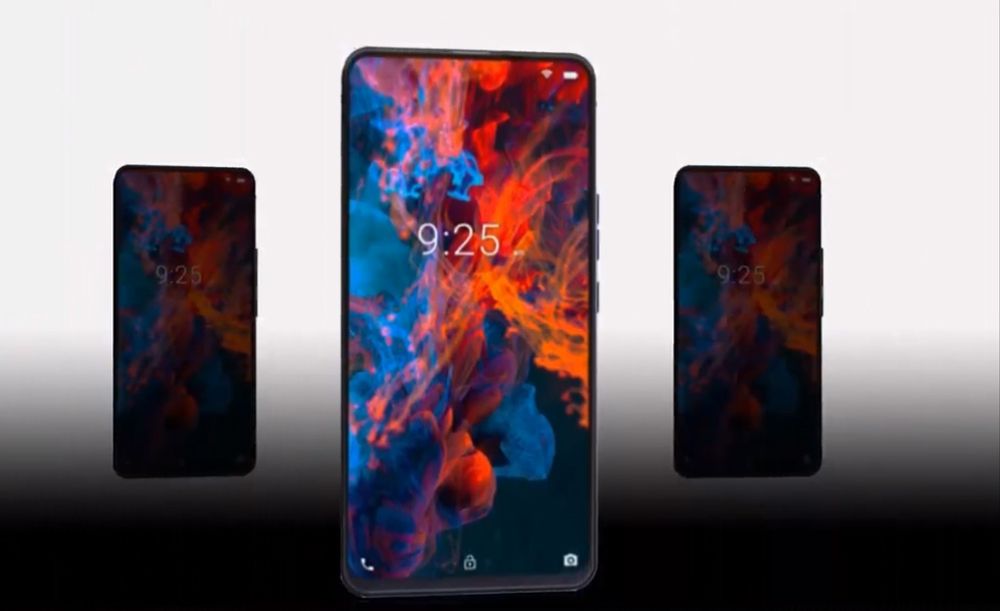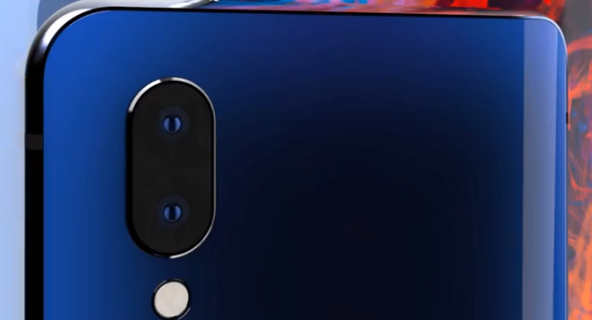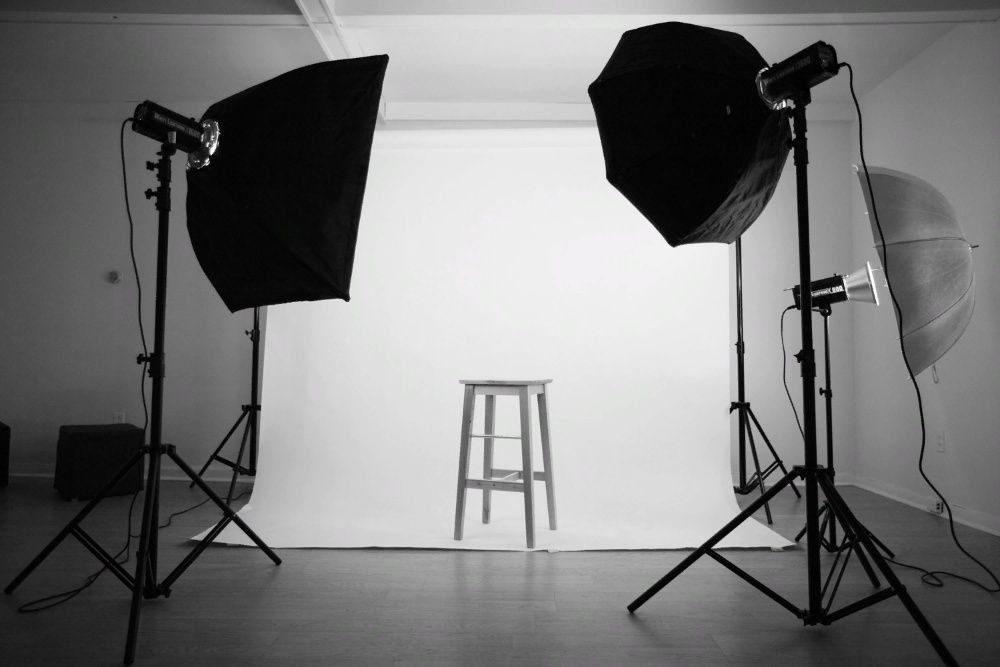Archos Diamond smartphone - advantages and disadvantages

Mobile market trends are constantly changing. Literally last year, there was a fashion for "monobrows" and "bangs" in smartphones, but now manufacturers, on the contrary, are trying to get rid of them. One of the solutions was slider phones, in which there is only a speaker in the upper part of the front panel, and the front camera is located in the retractable rear part.
This technology was adopted by the French company Archos.And she implemented it in her new mid-priced phone, Archos Diamond, combining such absolute trends this year as large frameless displays and tempered glass on both sides of the phone with slider technology.
The release of the phone is planned for May 2019, but for now you can consider what is already known about it, and there is already a lot of information about it. But first things first.
Design
As mentioned above, Archos decided to keep up with the trends, so the phone has a bezel-less display that occupies 85.2%, which is 6.4 inches diagonal. At the top of the screen, there is only a speaker, a camera, which can be pulled out using a special mechanism created on the basis of a slider.
At the bottom there is a speaker, a TypeC connector for charging, as well as a 3.5 mm audio output for connecting headphones, which, by the way, is also starting to go out of fashion.
On the left is a dual microSD card slot, while on the right is the traditional power button and volume rocker.
On the back is a lonely dual-sensor camera with LED backlighting. The entire back, as well as the display, is covered with tempered Corning Gorilla Glass 3.
Display

One of the main advantages of this device is a huge AMOLED display with a capacitive touchscreen and 16 million colors. The screen resolution is 1080x2340 pixels with an aspect ratio of 19.5: 9 with a ppi density of 403.
The screen turned out to be really beautiful, and the absence of bangs or a cutout only adds to its beauty. Of course, more detailed tests of brightness, color rendering, white balance and other characteristics can only be carried out after the phone is released, but judging by the available parameters, the display quality will be at a very high level.
It is also worth mentioning the very young technology of a fingerprint scanner built directly into the display. Here it is also implemented and, hopefully, very successfully.
Specifications
| Parameters | Specifications |
|---|---|
| Net: | LTE Bands 1,3,7,20,28 UMTS 900, 1900, 2100 GSM 900, 1800, 1900 |
| Platform: | Android 9.0 (Pie) |
| Display: | AMOLED, 6.39 ", 1080x2340, 16M colors, touch, capacitive, multitouch, Laminated AMOLED |
| Main camera: | 16 MP, flash, autofocus, dual 16 MP Sony IMX499 f / 1.8 + 5 MP Samsung 5E9 f / 2.2 |
| Front-camera: | 8 MP, f / 2.0, Samsung S5K4H7 with depth sensor |
| CPU: | MediaTek Helio P70 2.1 GHz, 4 x Cortex-A73, 4 x Cortex-A53, |
| Graphics chip: | Mali-G72 MP3 |
| RAM: | 4 GB |
| Inner memory: | 128 GB |
| Memory card: | Up to 512 GB |
| Navigation: | GPS, GLONASS, BeiDou |
| WI-FI: | Wi-Fi 802.11 a / b / g / n / ac, dual-band, Wi-Fi Direct, hotspot |
| Bluetooth: | 4.2, A2DP, LE |
| Sensors and scanners | Accelerometer, Gyroscope, Compass, Approach, Illumination, Fingerprint scanner. |
| Battery: | Li-Ion, 3400 mAh, wireless charging, 9V / 2A |
| Dimensions: | 158.7 x 74.1 x 8.6 mm |
| Weight: | 166 g |
| NFC system | there is |
CPU

Powered by a smartphone running a new processor for the middle class, MediaTek Helio P70. Its capabilities were first demonstrated in an Oppo smartphone for the Indian market, Realmi u1.
This single-chip system has performed impressively, beating the highly successful mid-range Snapdragon 660 chip.
The processor is based on the popular BIG technology. LITTLE and, like all SoCs created by this type, has a cluster of productive cores, which is represented by four Cortex A73 cores, clocked at 2.1 GHz. He is responsible for performing complex computational operations, as well as launching and maintaining heavy applications.
The second cluster is usually called energy-saving, as it is responsible for keeping the smartphone idle, and it is on these cores that applications that do not require much power are used. Such as social media or browser. Here it is represented by a cluster of 4 Cortex A53 cores with a frequency of 2.0 GHz.
Despite the fact that this chip successfully bypasses the Snapdragon 660 in performance, it was announced as a competitor to the Snapdragon 710, however, in order to identify the favorite in this category, detailed tests are needed, which are not currently available.
For this phone, such a chip is quite suitable, since its capabilities are enough to support a FullHD + screen with an aspect ratio of 20: 9, it can also work with dual-sensor cameras, with a resolution of 16 MP for the main sensor and 5 MP for the additional one.
It is also worth noting the presence of the MediaTek NeuroPilot neuroblock, thanks to which the built-in AI processes information during shooting 30% faster than the previous chip of the same series, and also adjusts the image quality during dialogue in Skype or Discord.
The graphics accelerator Mali-G72 is responsible for the graphics in games, which is more likely not for games, but for modeling virtual reality objects, interacting with AI and working with voice assistants.
Memory
According to the manufacturer, the new smartphone will have 128 GB of internal memory, which can be expanded thanks to a flash card with a maximum volume of 512 GB.
RAM is promised 4 GB, which is not bad, but there are no details about its speed yet.
Camera
Main

The rear camera consists of two sensors:
- The main 16MP, using Sony optics, specifically the IMX499 optical sensor with f / 1.8 aperture and PDAF phase detection autofocus, the principle of which phone manufacturers borrowed from SLR cameras and adapted for smartphones.
- Optional with 5MP resolution and f / 2.2 aperture notch. A special depth sensor is built into it, so it seems to come in handy when creating photos with a blur effect, aka the Bokeh effect.
There are two LED bulbs for flash under the camera.
In the software shooting settings, there is a panoramic mode and HDR settings. In addition, do not forget about the capabilities of the processor, and specifically the built-in neuroblock, which can automatically correct images on the fly.
As for video recording, the specification indicates the ability to shoot in 1080p quality at 30 frames per second, there is no other information yet.
Frontal

The selfie camera is interesting primarily for its sliding mechanism, made in the style of a slider. Otherwise, this is a pretty average, albeit good front camera with a resolution of 8 MP and aperture f / 2.0.
There is an HDR mode in the settings, in addition, it can also shoot video in FullHD resolution with the same frame rate as the main camera.
operating system

It is known that the phone will be preinstalled with the latest version of Android 9.0, which has long been popular for its integrated machine learning technology, which automatically adapts battery consumption depending on the applications being executed.
Also, the new gesture control system allows you to swipe from anywhere to open a list of recently used applications.
The new system allows you to set up reminders for popular applications so that the system, after a certain time, with the help of a notification, suggests, for example, to read a book or remind you of daily routine.
But the most discussed feature is the control of user activity. Thanks to a special application, you can set time restrictions on the use of applications or simply find out how much time a particular program takes.
No special features or additional applications are known yet.
Battery
Judging by the preliminary specification, the device will receive a Li-polymer battery with a capacity of 3400 mAh.
Despite the fact that this is a rather impressive battery, such a screen can consume a lot of energy, even if some of it is compensated by the Smart Battery system integrated into the new version of the OS.
Fortunately, the power consumption of the processor is not too high, so you can safely predict the day of battery life, if you do not take into account games or other heavy applications.
Advantages and disadvantages
- The main advantage is undoubtedly the display, which, although it does not represent some incredible innovation, is nevertheless of a sufficiently high quality, no worse than that of the flagships;
- The design is pretty good too. Although the phone is a compilation of popular trends, it doesn't make it any less beautiful. Tempered glass on both sides, bezel-less screen, all this still attracts attention, although not to say that it somehow stands out from other smartphones;
- The battery capacity is also a plus. Its capacity will be enough for a long battery life, especially if you take into account the energy-saving properties of the processor and the smart battery mode built into the OS itself.
- The main camera promises to be pretty average, especially in comparison with the top cameras, which have 3 or more sensors;
- The front camera is also not particularly remarkable, despite the interesting solution with a retractable mechanism.
Conclusion and cost
As a result, we can say that the phone will turn out to be a solid middling, combining almost all the most interesting things that are on the market, and the built-in NFC mode gives a big plus in its category.
It would also be interesting to see what the new processor from Mediatek is capable of, which the developers themselves dubbed the "Snapdragon 710 killer". It is doubtful that they will be able to make a graphics accelerator better than Adreno, but when it comes to working in multi-threaded mode, it may well come out the winner.
Also, apparently, it is worth waiting for the appearance on the market of even more sliders, as this technology is rapidly gaining popularity.
With such a balance of advantages and disadvantages, this phone can be considered for purchase, especially considering that its promised price will not exceed 300 euros, which will undoubtedly allow us to close our eyes to some imperfections of the camera.
new entries
Categories
Useful
Popular articles
-

Top rating of the best and inexpensive scooters up to 50 cubic meters in 2024
Views: 97661 -

Rating of the best materials for noise insulation for an apartment in 2024
Views: 95022 -

Rating of cheap analogues of expensive medicines for flu and colds for 2024
Views: 91751 -

The best men's running shoes in 2024
Views: 87681 -

Top ranking of the best smartwatches 2024 - price-quality
Views: 85091 -

Best Complex Vitamins in 2024
Views: 84801 -

The best dye for gray hair - 2024 top ranking
Views: 82406 -

Rating of the best wood paints for interior use in 2024
Views: 77202 -

Ranking of the best action cameras from China in 2024
Views: 75269 -

Rating of the best spinning reels in 2024
Views: 74827 -

The most effective calcium supplements for adults and children in 2024
Views: 72463 -

Top rating of the best in 2024 means for male potency with a description
Views: 68296








